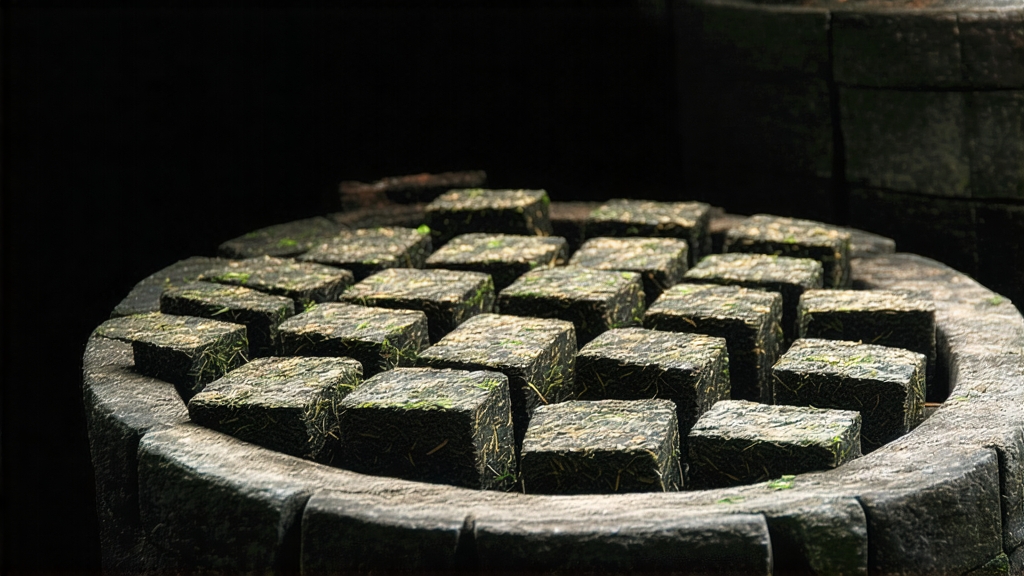
Tucked away in the subtropical mountains of southern China’s Guangxi Zhuang Autonomous Region, Liu Bao tea has spent four centuries quietly perfecting the art of microbial alchemy. To the uninitiated it is merely another dark brick on the shelf, yet to Chinese tea historians it is the “black pearl of the Maritime Silk Road,” the only tea that once traveled better than the ships that carried it. This article invites the global tea lover to explore Liu Bao’s origin myths, its unique wet-piling process, the poetry of its aging, and the sensory code that unlocks its deep, betel-nut sweetness.
-
From Frontier Currency to Imperial Tribute
Liu Bao takes its name from the old trading post of Liu Bao town in Wuzhou prefecture, where the Liu and Bao rivers converge. During the Ming dynasty (1368-1644) the tea was compressed into 40-kilogram bamboo baskets and bartered for salt, spices and horses with mountain tribes. By the Qing Qianlong era (1736-95) the emperor’s censors, impressed by its ability to calm digestion on humid southern journeys, listed Liu Bao as one of the 24 imperial tributes of Guangxi. European maritime records show that clipper ships leaving Wuzhou for Java and Calcutta in the 1840s routinely stowed Liu Bao beneath the waterline; the tea absorbed the briny air, ripening into a mellow liquor that Dutch doctors later prescribed for dysentery. Thus Liu Bao became one of the first Chinese teas to develop an international reputation not for delicacy but for medicinal stamina. -
Terroir: Where Mist, Red Soil and Camellia Meet
The micro-region lies between 23° and 24° north latitude, where the Dayao and Yaochong mountains trap monsoon clouds that shroud tea gardens 300–800 m above sea level. The soil is lateritic, rich in iron and potassium, and drains quickly—ideal for the large-leaf Camellia sinensis var. assamica strain native since the Tang dynasty. Farmers still intercrop with cinnamon and star-anise, believing the aromatic roots impart a subtle spiciness to the tea. Because the area sits on the same tectonic belt as Pu-erh’s Yunnan, Liu Bao shares some microbial DNA with its famous cousin, yet the higher humidity and warmer winters give Liu Bao a rounder, more “betel-nose” character. -
Crafting the Darkness: A Tale of Two Fermentations
Unlike green tea that chases freshness, Liu Bao courts time. The journey begins in late April when pickers pluck one bud with three or four leaves, slightly tougher material than spring green tea. After solar withering for three hours the leaves are wok-fried at 200 °C for eight minutes to kill green enzymes, then rolled for 30 minutes to rupture cells. What follows is the first fermentation: the damp piles are heaped 40 cm deep in bamboo trays and left for 12 hours at 28 °C, turning every two hours to oxidize catechins into theaflavins. Yet this is only the prelude.
The signature step is “wet piling” (wo dui), a technique that predates Pu-erh’s adoption by at least a century. Workers spray 10 % moisture over the semi-oxidized leaves, then stack them 70 cm high under jute sacks. Inside the pile thermophilic bacteria (Bacillus subtilis, Aspergillus niger) raise the core temperature to 55 °C within 36 hours. Every four days the pile is turned, aerated and re-moistened; the cycle repeats for 25–30 days until the leaf color turns chestnut-brown and a damp-earthy aroma reminiscent of forest loam emerges. Microbiologists have isolated over 190 fungal strains, including a unique Wuzhou strain of Eurotium cristatum that forms golden “golden flowers” (jin hua) on aged cakes, the same desirable mold that blesses premium Fu brick tea.
After piling the tea is steamed, pressed into 30–50 kg bamboo baskets lined with banana leaves, and transferred to government-licensed aging cellars built from local red clay. The clay walls breathe, maintaining 75 % humidity and 25 °C year-round. Here Liu Bao sleeps for a legal minimum of three years before market release,